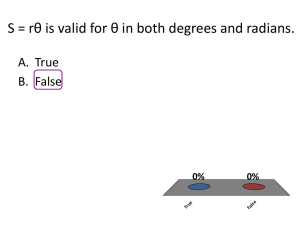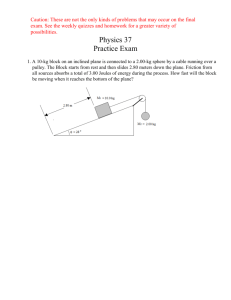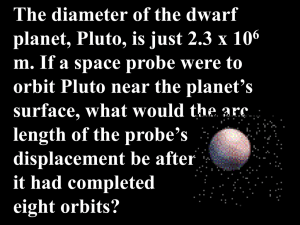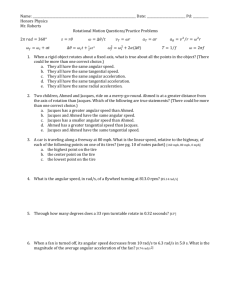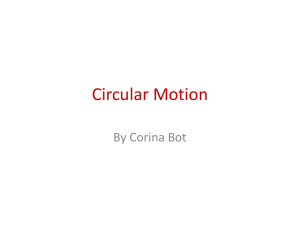practice test rotational motion key
advertisement
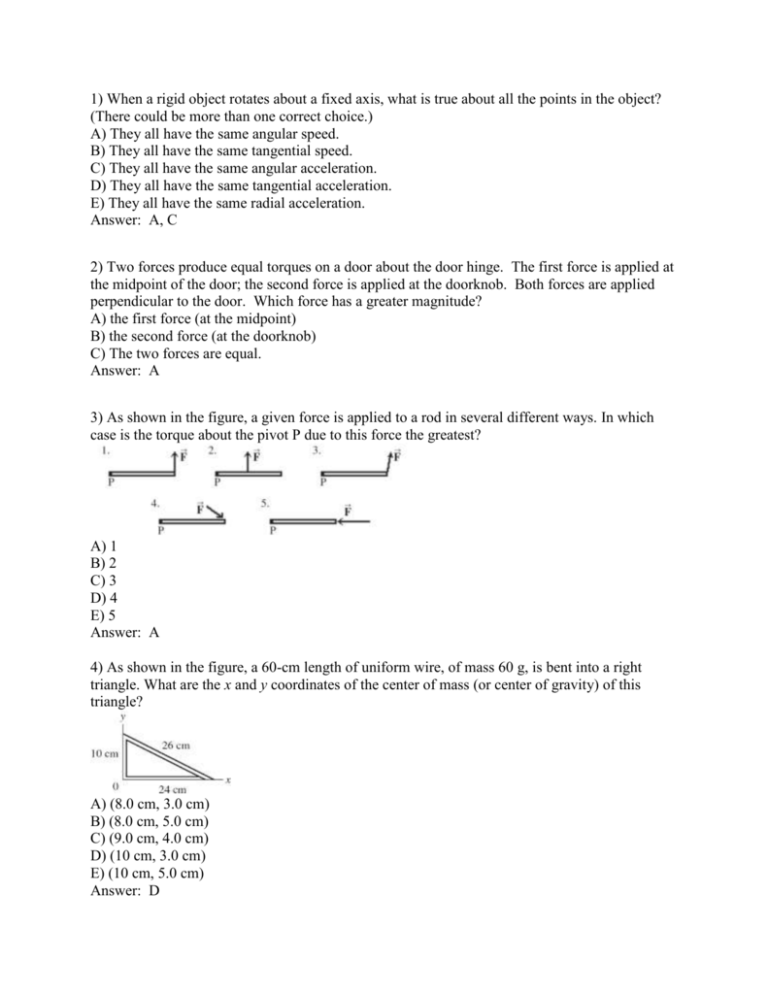
1) When a rigid object rotates about a fixed axis, what is true about all the points in the object? (There could be more than one correct choice.) A) They all have the same angular speed. B) They all have the same tangential speed. C) They all have the same angular acceleration. D) They all have the same tangential acceleration. E) They all have the same radial acceleration. Answer: A, C 2) Two forces produce equal torques on a door about the door hinge. The first force is applied at the midpoint of the door; the second force is applied at the doorknob. Both forces are applied perpendicular to the door. Which force has a greater magnitude? A) the first force (at the midpoint) B) the second force (at the doorknob) C) The two forces are equal. Answer: A 3) As shown in the figure, a given force is applied to a rod in several different ways. In which case is the torque about the pivot P due to this force the greatest? A) 1 B) 2 C) 3 D) 4 E) 5 Answer: A 4) As shown in the figure, a 60-cm length of uniform wire, of mass 60 g, is bent into a right triangle. What are the x and y coordinates of the center of mass (or center of gravity) of this triangle? A) (8.0 cm, 3.0 cm) B) (8.0 cm, 5.0 cm) C) (9.0 cm, 4.0 cm) D) (10 cm, 3.0 cm) E) (10 cm, 5.0 cm) Answer: D 5) A 2.0-m rope is lying on a table. You pick up one end and start raising it vertically. How high above the table is the center of mass (or center of gravity) of the rope when half of the rope has lifted off the table? A) 0.25 m B) 0.50 m C) 0.75 m D) 1.0 m E) 1.5 m Answer: A 6) A 3.0-kg mass is located at (0.0 m, 8.0 m), and a 1.0-kg mass is located at (12 m, 0.0 m). You want to add a 4.0-kg mass so that the center of mass (or center of gravity) of the three-mass system will be at the origin. What should be the coordinates of the 4.0-kg mass? A) (-3.0 m, -6.0 m) B) (-12 m, -8.0 m) C) (3.0 m, 6.0 m) D) (-6.0 m, -3.0 m) Answer: A 7) An artificial satellite in a low orbit circles the earth every 98 minutes. What is its angular speed in rad/s? Answer: 0.0011 rad/s 8) At a certain instant, a compact disc is rotating at 210 rpm. What is its angular speed in rad/s? A) 11 rad/s B) 22 rad/s C) 45 rad/s D) 69 rad/s E) 660 rad/s Answer: B 9) A cylinder of radius 8.0 cm rolls 20 cm in 5.0 s without slipping. Through how many degrees does the cylinder turn during this time? Answer: 140° 10) A wheel of diameter 0.70 m rolls on the floor without slipping. A point at the top of the wheel moves with a speed 2.0 m/s relative to the floor. (a) At what speed is the central axis of the wheel moving relative to the floor? (b) What is the angular speed of the wheel? Answer: (a) 1.0 m/s (b) 2.9 rad/s 11) A scooter has wheels with a diameter of 120 mm. What is the angular speed of the wheels when the scooter is moving forward at 6.00 m/s? A) 47.7 rpm B) 955 rpm C) 72.0 rpm D) 50.0 rpm E) 100 rpm Answer: B Var: 1 12) A bicycle has wheels that are 60 cm in diameter. What is the angular speed of these wheels when it is moving at 4.0 m/s? A) 1.2 rad/s B) 4.8 rad/s C) 0.36 rad/s D) 13 rad/s E) 7.6 rad/s Answer: D 13) How long does it take for a rotating object to speed up from 15.0 rad/s to 33.3 rad/s if it has a uniform angular acceleration of 3.45 rad/s2? A) 4.35 s B) 5.30 s C) 9.57 s D) 10.6 s E) 63.1 s Answer: B 14) A machinist turns on the power on to a grinding wheel at time t = 0 s. The wheel accelerates uniformly from rest for 10 s and reaches the operating angular speed of The wheel is run at that angular velocity for 30 s, and then power is shut off. The wheel slows down uniformly at until the wheel stops. What is the total number of revolutions made by the wheel in this situation? A) 510 B) 280 C) 320 D) 470 E) 750 Answer: A 15) A wheel rotates through an angle of 13.8 rad as it slows down uniformly from 22.0 rad/s to 13.5 rad/s. What is the magnitude of the angular acceleration of the wheel? A) 0.616 rad/s2 B) 5.45 rad/s2 C) 111 rad/s2 D) 22.5 rad/s2 E) 10.9 rad/s2 Answer: E 16) A centrifuge in a medical laboratory rotates at a rotational speed of 3600 rev/min. When switched off, it makes 50 complete turns at a constant angular acceleration before coming to rest. (a) What was the magnitude of the angular acceleration of the centrifuge as it slowed down? (d) How long did it take for the centrifuge to come to rest after being turned off? Answer: (a) 230 rad/s2 (b) 1.7 s 17) A man in a gym is holding an 8.0-kg weight at arm's length, a distance of 0.55 m from his shoulder joint. What is the torque about his shoulder joint due to the weight if his arm is held at 30° below the horizontal? A) 22 N ∙ m B) 2.2 N ∙ m C) 4.4 N ∙ m D) 13 N ∙ m E) 37 N ∙ m Answer: E 18) The figure shows a person's foot. In that figure, the Achilles tendon exerts a force of magnitude F = 720 N. What is the magnitude of the torque that this force produces about the ankle joint? A) 12 N ∙ m B) 16 N ∙ m C) 21 N ∙ m D) 26 N ∙ m E) 36 N ∙ m Answer: B
